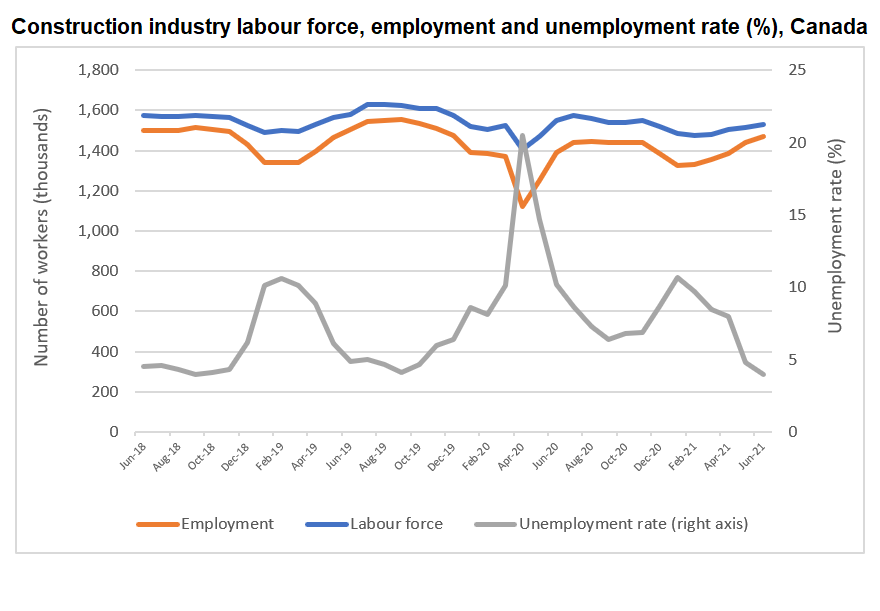Construction continued its slow climb back to pre-pandemic levels in June.
Data released by Statistics Canada in its latest Labour Force Survey report show the industry added 27,000 workers (+1.9%) during the month. That increase brings industry employment across the country to 1.468 million – 75,900 workers (+5.4%) higher than in June 2020, but 44,600 workers below the total recorded in June 2019.
Statistics Canada collected data for its LFS during the week of June 13 to 19. At that time, public health restrictions had been significantly eased in several provinces. Ontario, for example, lifted its stay-at-home order prior to the reference week. Manitoba, however, remained under public health restrictions.
Key indicators show positive signs
Some of constructions key labour force indicators are showing positive signs.
Employment, for example, recorded gains in most provinces month over month in June, and is higher in most parts of the country than it was a year ago. Newfoundland and Labrador recorded the highest year-over-year growth in employment at 18.3%, with Nova Scotia and Quebec also seeing annual increases of greater than 10%. Conversely, employment is lower year over year in Prince Edward Island (-22.8%), New Brunswick (-6.9%), and British Columbia (-4.2%).
Only two provinces – Quebec and Nova Scotia – have seen their respective workforces increase compared with June 2019, though Ontario is not far off pre-pandemic levels.

Meanwhile, construction’s month-over-month unemployment rate declined a further 0.8 percentage points to 4% in June. The rate remains 6.3 percentage points below June 2020 levels and 0.8 points below 2019 levels.
The rate of unemployment continued to decline in most provinces in June. New Brunswick saw the most notable decline in the unemployment rate, falling to 6.8% from 13.1% in May. Quebec and Nova Scotia also reported notable declines of -3.4% and -2.8% respectively. In contrast, Alberta (+2.3%), Newfoundland and Labrador (+1.8%), and British Columbia (+1%) saw their respective unemployment rates rise in June. Manitoba remained relatively unchanged.
The unemployment rate was lower across provinces when compared to June 2020 levels. Most provinces also reported lower rates of unemployment compared to pre-pandemic levels of June 2019.
Hours worked are up over June 2020
As restrictions on public gatherings subside, construction is operating fully – and at a much higher capacity than it was at this time last year. National hours worked in June 2021 were 12.5% higher than in June 2020, but remain more than 6% below levels seen in June 2019.
Although Prince Edward Island and New Brunswick reported fewer hours worked year over year, the remaining provinces all reported gains. Newfoundland and Labrador (+27.6%) and Saskatchewan (+25.2%) experienced the most notable increases. Newfoundland and Labrador (+19.9%) and New Brunswick (+18.6%) also reported notable month-over-month gains, while the remaining provinces reported more modest increases in hours worked (<10%).
British Columbia was the only province to report a decline in hours worked from May levels.
Investment in building construction
In a further sign of a recovering economy, the latest release of Statistics Canada’s “Investment in building construction” shows investment levels for households, businesses, and governments continued to rise in May. Since January 2021, levels increased month over month from $15.9 billion to $18.5 billion in May 2021.

